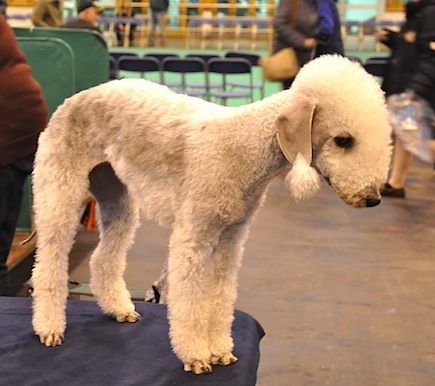
Breed
Bedlington Terrier
Group
Terrier
Physical Description
There’s no hiding the resemblance to a lamb with this dog; it is often referred to as one of the many funny-looking dog breeds.
The Bedlington Terrier has a wedge-shaped head, small almond-shaped eyes and a tapered tail. The back legs are slightly longer than the front legs. The weight averages from 17 to 23 pounds and height ranges from 15 to 17 inches.
Bedlingtons start out with dark hair as a puppy, and the coat gradually lightens as they age, turning blue, sandy, liver or variations of these colors mixed with tan.
The average life span is around 16 years, but some have reportedly lived past 20 years of age.
Origin
The Bedlington’s name comes from the mining town in which the breed originated in Northumberland County, England.
The breed was originally known as the Rothbury terrier, named after Lord Rothbury, an enthusiast of the breed. The earliest known Bedlington was begotten by a dog named Coates Phoebe, owned by Joseph Ainsley in 1820.
The dog was bred in 1825 and is said to have produced the first Bedlington Terrier, named Piper.
Bedlingtons are small dogs, very skilled and were used to hunt badgers and vermin.
The National Bedlington Terrier Club of England was formed in 1877, and the American Kennel Club (AKC) recognized the breed in 1886. The Kennel Club in England recognized the breed in 1898.
Purpose
Originally bred in England for hunting, Bedlingtons today are companion pets and competitive show dogs. They also compete in agility, obedience, rally and earthdog competitions.
Temperament
Some owners report their Bedlingtons as constant barkers, but the breed is also described as gentle, energetic, graceful, alert and intelligent. They are good watchdogs and are easily trained. As a bonus, they are affectionate with their families and good with children.
Check out this Bedlington named Rocco. His human taught him to speak for treats:

Exercise Needs
This breed is fairly active indoors, so they can do well in apartments, but need sufficient exercise, including daily walks.
If they don’t get enough exercise, they can become bored and mischievous. Bedlingtons are fond of digging, so an area set aside for this purpose may be necessary.
They are fast runners and like to chase, so don’t let them off the leash in a large area.
Grooming Requirements
Bedlingtons shed very little, if at all, making them great dogs for those who suffer from allergies.
They need a trimming every two months. This can be done by a professional groomer or an owner with experience. If the dog is competing in conformation, the trim needs to be short on the body but can be longer on the legs.
The skin of a Bedlington does not dry out like other breeds, so they can be bathed more often, if necessary.
A weekly brush is recommended, as well as brushing your pet’s teeth, cleaning the ears and clipping the dog’s nails.

Common Health Problems
Bedlingtons do have a few health issues to be aware of:
- Copper toxicosis (genetic condition where copper builds up in the liver)
- Hereditary kidney disease/renal failure
- Thyroid problems
- Eye problems such as cataracts and retinal disease
- Ear infections
While this list is short, some of the conditions can be serious. If you are buying or adopting a Bedlington from a breeder, ask to see the health certificates for the dog’s parents or the dog, if available.
Is the Bedlington Terrier the Right Dog for You?
Bedlingtons are small dogs but active indoors. This makes them suitable for apartment life with a daily walk. This is a fast breed, and the chance of running off in a chase is possible. They are good with kids and affectionate with their owners.
Grooming will require a full trim of the coat every two months, so be prepared for this expense; or, just learn how to perform the trimming yourself. There are a few health concerns to be aware of with this breed.
Bedlingtons are gentle and sweet dogs that would be a great addition to any home.
Adopt, Don’t Buy
If you consider getting a Bedlington, please turn first to adoption resources. Even purebred animals land in shelters sometimes. Try Petful’s adoptable pets search.
You can also check with rescue groups and breeders. Make sure the breeder is reputable.
Additional Resources
- Breed Information: The American Kennel Club (AKC)
- Breed Club: The National Bedlington Terrier Club (UK)
- Breed Club: The Bedlington Terrier Club of America








